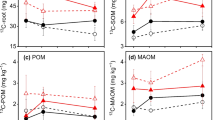Abstract.
Aiming to investigate whether a carbon-to-nitrogen equilibrium model describes resource allocation in lichens, net photosynthesis (NP), respiration (R), concentrations of nitrogen (N), chlorophyll (Chl), chitin and ergosterol were investigated in 75 different lichen associations collected in Antarctica, Arctic Canada, boreal Sweden, and temperate/subtropical forests of Tenerife, South Africa and Japan. The lichens had various morphologies and represented seven photobiont and 41 mycobiont genera. Chl a, chitin and ergosterol were used as indirect markers of photobiont activity, fungal biomass and fungal respiration, respectively. The lichens were divided into three groups according to photobiont: (1) species with green algae, (2) species with cyanobacteria, and (3) tripartite species with green algal photobionts and cyanobacteria in cephalodia. Across species, thallus N concentration ranged from 1 to 50 mg g–1 dry wt., NP varied 50-fold, and R 10-fold. In average, green algal lichens had the lowest, cyanobacterial Nostoc lichens the highest and tripartite lichens intermediate N concentrations. All three markers increased with thallus N concentration, and lichens with the highest Chl a and N concentrations had the highest rates of both P and R. Chl a alone accounted for ca. 30% of variation in NP and R across species. On average, the photosynthetic efficiency quotient [K F=(NPmax+R)/R)] ranged from 2.4 to 8.6, being higher in fruticose green algal lichens than in foliose Nostoc lichens. The former group invested more N in Chl a and this trait increased NPmax while decreasing R. In general terms, the investigated lichens invested N resources such that their maximal C input capacity matched their respiratory C demand around a similar (positive) equilibrium across species. However, it is not clear how this apparent optimisation of resource use is regulated in these symbiotic organisms.
Similar content being viewed by others
Author information
Authors and Affiliations
Corresponding author
Additional information
Electronic Publication
Rights and permissions
About this article
Cite this article
Palmqvist, K., Dahlman, L., Valladares, F. et al. CO2 exchange and thallus nitrogen across 75 contrasting lichen associations from different climate zones. Oecologia 133, 295–306 (2002). https://doi.org/10.1007/s00442-002-1019-0
Received:
Accepted:
Published:
Issue Date:
DOI: https://doi.org/10.1007/s00442-002-1019-0




